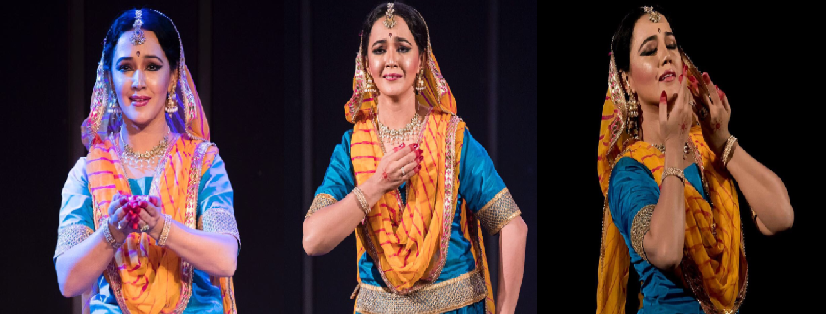When Dance Embraces Divinity
RASHMI OBEROI

Swaying like the summer breeze, Divya Goswami Dikshit completely mesmerises you during her Kathak dance recitals. The energy that flows through her flawless dance movements leaves you breathless and stunned. The journey of experiencing fulfilment can only be felt by such a dancer who transforms herself through the synergy she feels.
One of the eight forms of India's classical dances, Kathak, meaning ‘story teller’ originated in Uttar Pradesh, a state in northern India, and there are references to this dance form in sources dating from the third and fourth centuries B.C. ‘Kathakars’ or story-tellers, are people who narrate stories largely based on episodes from the epics, myths and legends. Kathak dance, today characterized by fast, rhythmic footwork, became sophisticated court entertainment with the advent of Mogul culture in northern India.
A spellbinding and beautiful Kathak presentation held on 21st August 2017 at the India Habitat Centre, New Delhi by Divya was a treat to watch. She presented herself with élan and grace. It was a stunning performance delivered with veneration and sophistication with the costume changes between dances handled with subtlety. Divya, a disciple of Guru Munna Shukla, presented an evening of Kathak showcasing its rich traditional journey, accompanied by live musicians.
The repertoire brought out the essence of the Lucknow Gharana of Kathak. Her accompanying artistes were: Shakeel Ahmad (Tabla), Amrita Majumdar (Vocals and Harmonium), Ghanshyam Sisodia (Sarangi), Jyotsana Banerjee Shukla (Padhant) and Kiran Kumar (Flute).
Divya has the power to present a story through her facial expressions, dancing feet and hand movements. She engages her audience with a recital that radiates sensitivity, delicateness and simplicity. Her Kathak performances are unadulterated which is rare to see these days.
One of the most emphatic dance forms that the City of Nawabs has given - the Lucknow Gharana of Kathak, came into existence mainly in the court of Nawab Wajid Ali Shah, the last ruler of Avadh in the 19th Century. He established the Lucknow Gharana with its strong accent on ‘bhava’ - the expression of moods and emotions.
Kathak, its exponents say, was so powerful that no other dance form posed a challenge to it for a long period. Music has always been a companion to dance. One cannot think of dance without music. In classical Kathak dance, music played the role of timekeeper in the form of a ‘lehara’ played on the sarangi.
Divya dances with total abandon once she gives thanks to her Gurus. Her Guru’s blessings are sacred to her. She believes in what Osho once said: "Love is the soul of dance; dance, the body of love." In the midst of all the movement and chaos and energy one must find the stillness she says.
Born into the family of the legendary Hindu philosopher of Vedanta, Swami Ram Tirtha, Divya is the disciple of the great Kathak maestro Guru Munna Shukla. She was initiated at an early age in the Lucknow Gharana of Kathak under the able guidance of Smt. Yogini Gandhi at the Kalanidhi institute at Pune. This is where Divya received training, performed and taught for over fifteen years. Divya today continues her learning of this rich classical dance form under the tutelage of her Guru.
Divya has been bestowed with the coveted ‘Ustad Bismillah Khan Yuva Purushkar’ by the apex body of performing arts in India, Central Sangeet Natak Academy. She is also a recipient of the prestigious National level title ‘Singar Mani’ conferred by the Sur Singar Samsad, Mumbai. Divya is an empanelled artist of SPICMACAY and also a Doordarshan graded artist.
Divya is anchored to the roots of the traditional expositions of Kathak. She holds close the spiritual and meditative aspects of the art form that translate into her dance. With the belief that dance is a medium of 'self-evolvement’, she has showcased the rich classical culture of Kathak in India and abroad.
Divya commenced the evening’s performance with Meera’s Krishna experience. For this great saint of Rajasthan, Krishna has been her only reality. This ‘pada’ captured the moment when Meera had the divine vision of Banke Bihari in Vrindavan. She is bewitched by the beauty of the blue God and the soul nourishing music which emanates from his flute. Meera completely surrenders to Krishna, her beloved, protector of the universe.
The ‘Nritta Paksha’ in Kathak is a wonderful confluence, a synthesis of the Hindu and Moghul culture. The structure of traditional Kathak follows a steady progression of the rhythm and energy, from ‘vilambit’ i.e. slow to ‘drut’ the fast speed. There is a gradual build up in the dance through short compositions. The dance passages are aptly punctuated with lyrical use of the wrist, subtle body movements, characteristic pirouettes, melodic padhant and intricate use of feet.
To conclude the evening’s recital, Divya presented a Tarana set to Raag Bhairavi in Teen Taal. The birth of Tarana credited to Amir Khusro, is a song that uses mnemonic syllables. These words although without a meaning, come alive when tied in melody and rhythm. This allows the artist to break free from the barrier of words into the world of the abstract and formless. Interwoven in the Tarana is the quintessential feature of Kathak – ‘A Gat Nikas’.
Dance is truly a celebration of each moment in life through rhythm, movement and expression. Divya dances to inspire and puts forward a timeless interpretation of life for her audience.



